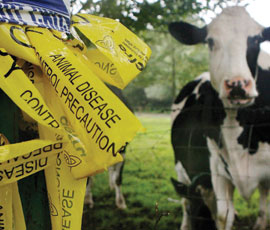Farmers urged to be vigilant as foot-and-mouth spreads

Farmers have been urged not to be complacent, as foot-and-mouth disease continues to take hold in the Middle East.
The highly infectious disease was first found in Egypt and Libya in February, but since then it has spread to the Gaza Strip, on the border of Egypt.
Tests confirmed the virus strain was SAT 2 – a new strain in Egypt, which is normally found in wild animals in sub-Saharan Africa.
“The virus is definitely on the move and we must not be complacent.”
Jef Hammond, Foot-And-Mouth Disease World Reference Laboratory
Jef Hammond, head of the Foot-And-Mouth Disease World Reference Laboratory, said the outbreak was a “very short step” away from Turkey, which could provide a gateway for the disease to spread throughout Europe.
“The virus is definitely on the move and we must not be complacent,” he told producers at the NFU’s disease conference.
Clinical symptoms farmers are being urged to keep a close watch for are:
- Fever and dullness in livestock.
- In dairy animals the disease may mean animals are off their feed and milk yield may be reduced as a result.
- Cattle may have a raised temperature and could be salivating at the mouth.
- Loss of weight might be a result of the animal being unable to eat because its mouth is too painful.
- Severe and sudden lameness. The animal may also be lying down frequently.
- Increased mortality in newborn lambs.
- Mouth symptoms are not always visible but blisters may develop on hoof or tongue.
- In pigs blisters may develop on the snout too.
Take a look at pictures showing specific foot-and-mouth symptoms on our dedicated symptoms page at www.fwi.co.uk/footandmouth
